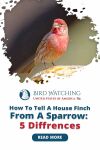
What’s This Post About?
Cardinals come from a family line of their own called the Cardinalidae and they are mostly found across most parts of America and Canada. Cardinals are 8cm to 3/4th of an inch long from bill to tail. Their wings span 12 inches and these birds are about 45g in weight.
However, cardinals are not the only birds that are part of the Cardinalidae family. Birds such as finches, towhees, and tanagers also originate from the same family line.
Due to this very reason, it can be somewhat tricky to tell the difference between the Cardinals and other birds.
The bright scarlet hues aren’t exactly unique to the Cardinals only. Several times these birds have been mistaken for the Summer and Scarlet Tanagers, House Finches, Vermillion Flycatchers and Pyrrhuloxias. Though similar in appearance, every species has its own set of distinctive characteristics.

What Do Cardinals Look Like?
Cardinals are medium-sized, scarlet-colored birds with a pointed flock of feathers just behind the crown. These songbirds have fairly large heads, shorter wings, and fuller tails.
Although quite different in appearance, cardinals are known to behave similarly to sparrows. Some birds such as towhees even look very much like these cardinals. To be able to tell the difference, there are a few minute details that you will have to keep in mind.

Fun Fact
The name of the cardinals comes from the founding colonists of the United States. Catholic cardinals have similar red biretta and plumage, just like these scarlet feathered birds.
Learning About Cardinals from Close Up!
Northern Cardinals are mostly bright orange-red with a bright beak and dark wings. The beak is curved at the upper ridge. Cardinals have broad wings and a long broad tail during the flight. Their flights are usually slow and direct.

Their flight path is straight and does not waver much. Cardinals don’t fly too far at one time. When they fly, they mostly stay closer to the ground.
These songbirds have a loud and fairly sweet sing-along voice. Both genders sing in high-pitched whistling sounds, often even found in an early morning duet.
Fun Fact
The songs that Cardinals sing sound a lot like they are saying “birdie birdie birdie” or “cheer cheer cheer”. For birdwatchers, this distinctive sound is easy to locate and identify as this sound is unique to cardinals only.
Which Birds Look Like Cardinals?
There are a couple of birds that resemble the cardinals a great deal. These birds include Summer Tanagers, Scarlet Tanagers, House Finches, Vermillion Flycatchers, and Pyrrhuloxias.
To learn more about how you can identify these birds, continue to read on.
1. Summer Tanager
Same Size - Different Color.

The tanagers and the cardinals are similar in size, especially the male species.
The Summer Tanager has a shorter tail and longer wings. It has a pale-yellow beak that’s thicker towards the tip and narrower around the base.
Male and female tanagers are greenish-yellow in their first year of life. The males may have a few blotches of red sprinkled around, but neither gender turns fully red until they are about 2 years old.
Summer Tanagers are mostly found in the southeast or southwest of the United States. During the migration season, they might even be seen around Florida or Texas.
The Summer Tanagers do not have crests.
Hard Truth
The average life span of a cardinal is around 3 years. This is usually due to the species being more susceptible to predators, disease, and starvation.
2. Scarlet Tanager
Distinct tails and wings!

The Scarlet Tanager is a bright red bird with a darker tail and wings.
Astonishingly, the Scarlet Tanager tends to change color around wintertime, turning green around the top and yellow around the bottom with the same dark tail and wings.
The Scarlet Tanager is found near the Mideast and Northwest of the United States. They sometimes even migrate southwards, outside of the US.
3. House Finch
Small and Hot-headed!

The House Finch is a small and very common, red-headed bird found nearly in every backyard across the United States.
Mostly found in the trees and hardly ever on the ground, House Finches are brownish striped birds, with red, only in a small patch on the head.
The Purple finch, similar to the House Finch is found mostly in the northern areas in coniferous regions.
4. Vermillion Flycatcher
You won’t find them at heights.

Usually found perched up on low tree branches, the Vermillion Flycatcher is more of a desert bird.
During the migration season, you can find them near California to Alabama, but not too far north as these birds prefer warmer climates.
The Vermillion Flycatcher is a bright red bird with blotches of black on the tail, wings, and back. It has a short, flat, and darker bill. The raised crown feathers are what sets it apart from other birds.
The Vermillion Flycatcher does not feed on the ground. These birds usually prefer a quick catch and eating style where they fly out and catch insect’s midair, bring them back to the tree branches and devour them skillfully, whilst perched up straight on their designated spot.
Their eating habits set them apart from most other birds.
Fun Fact
Cardinals are generally the first bird to visit the feeders in the morning and the last birds to visit in the evening.
5. Pyrrhuloxia
Stunningly beautiful outlook.

The pyrrhuloxias and northern cardinals are often found together, in southern Texas, southern New Mexico, and Arizona. Distinguishing the cardinals from the Pyrrhuloxias can therefore be a tad bit difficult.
While the Pyrrhuloxias usually prefer deserts, the northern cardinals can on the contrary be found in residential backyards. The habitats are, therefore, one way to tell the two species apart.
More so, Pyrrhuloxias are also named The Desert Cardinal. Another way to tell them apart is two recognize the difference in appearance. Pyrrhuloxias are pale-grey colored birds with blotches of red on the crest, wings, tail, and neck areas.
They have a thick yellow beak, curbed at its upper ridge.
Keep Reading!
Although large, the Cardinalidae family consists of uniquely similar, yet dissimilar species of birds. The five species of birds that resemble cardinals a great deal include House Finches, Vermillion Flycatchers, Summer Tanagers, Scarlet Tanagers, and Pyrrhuloxias.
Sprung from the same gene pool, these birds are your genetic family siblings. While it is noticeable how they may be related, changes in behavioral patterns and minuscule details in the outward appearance will help you figure out which birds are the ones you may have come across in your backyard.
If you’re a keen birdwatcher and wish to know more about birds, I would recommend you to read my blog on whether hummingbirds change colors or not.
Do Hummingbirds Change Colors? We Have Some Cool Footage
It is often wondered among bird lovers whether hummingbirds change colors or not? To find out more, read through the post!

By David A. Swanson
Bird Watching USA
My name is David and I'm the the founder of Bird Watching USA! I started Bird Watching with My father-in-law many years ago, and I've become an addict to watching these beautiful creatures. I've learnt so much over about bird watching over the years that I want to share with the world everything I know about them!

David A. Swanson
Bird Watching USA
My name is David and I'm the the founder of Bird Watching USA! I started Bird Watching with My father-in-law many years ago, and I've become an addict to watching these beautiful creatures. I've learnt so much over about bird watching over the years that I want to share with the world everything I know about them!





![What Do Baby Hummingbirds Look Like? [12 Pictures!] Thumbnail](/assets/resized/img/posts/what-do-baby-hummingbirds-look-like-100x150.jpg)


![What Do Baby Hummingbirds Look Like? [12 Pictures!] Thumbnail](/assets/resized/img/posts/what-do-baby-hummingbirds-look-like_thumbnail-100x56.jpg)
